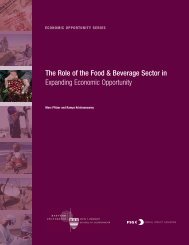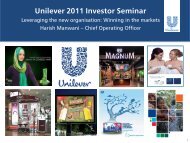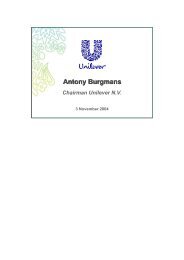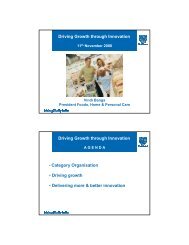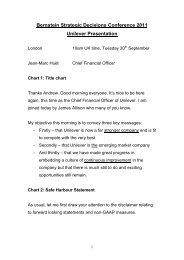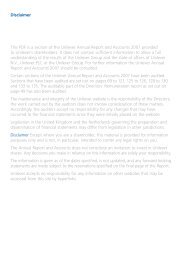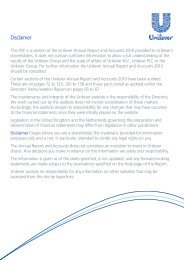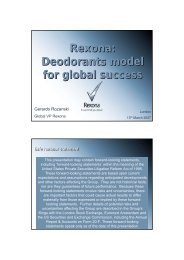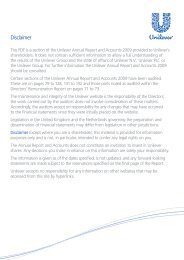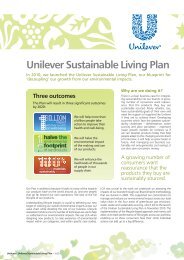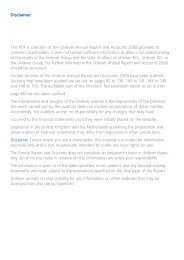Paper & board policy FAQx - Unilever
Paper & board policy FAQx - Unilever
Paper & board policy FAQx - Unilever
You also want an ePaper? Increase the reach of your titles
YUMPU automatically turns print PDFs into web optimized ePapers that Google loves.
• What is <strong>Unilever</strong>’s definition of “recycled” material?<br />
Fundamentally “recycling” means giving material a second life rather than simply disposing of it. The<br />
recycled material used for our packaging comes from two main sources. “Post consumer waste” is<br />
packaging which has been used i.e. it has served its purpose. This represents around 85% of material<br />
used in our recycled packaging. The other (minor) source of recycled material is “post industrial”. This<br />
is material which for one reason or other was not used directly for the packaging. The most common<br />
form of post industrial waste is “clippings”, which is waste that is generated when packaging is cut to<br />
shape. As both post consumer and post industrial waste would be disposed of by sending it to landfill if<br />
not recycled, we do not differentiate between them.<br />
• How do you choose which fibres you use for an application, virgin or recycled?<br />
We start by looking at the application and what the packaging is required to do. Where safety<br />
regulations demand a virgin material then the choice is very simple. Where there is a choice it will be<br />
the best material for the application and the material that is most readily available, as not all materials<br />
are available everywhere. If we have a choice and recycled material is available delivering the<br />
performance required then we will give preference to recycled material.<br />
• How are you monitoring progress against your ambitious milestones?<br />
We require our suppliers to do a self-assessment and report on progress via internet enabled tool. The<br />
assessment data will be accessible to Rainforest Alliance for verification. We will also audit our<br />
suppliers’ self assessment on a regular basis using 3 rd party auditors.<br />
• Is there sufficient certified material available to achieve your 2020 milestone?<br />
Based on information from FSC and PEFC (full statistics can be found on<br />
http://www.fsc.org/publications.html and www.pefc.org/index.php/about-pefc/who-we-are/facts-afigures)<br />
the certified forest area is continuously growing globally.<br />
Our ambition will be to prompt our suppliers and their supply chain back to the forest towards a<br />
credible and acceptable certification that will have beneficial impacts on the ground.<br />
Thus, with the statistics on our side and the strong efforts we will make in order to move all our supply<br />
chain towards certified or recycled sources, we believe our goal will be achieved.<br />
Implementation guidelines<br />
• What sources have been used to define the Country Exception List?<br />
To comply with our Country Exception List we have consulted the publicly available information on the<br />
issues that affect our Policy (illegal logging; violation of traditional and civil rights; forests where high<br />
conservation values are threatened or forests being converted to plantations or non-forest use)<br />
The sources used have been:<br />
3




